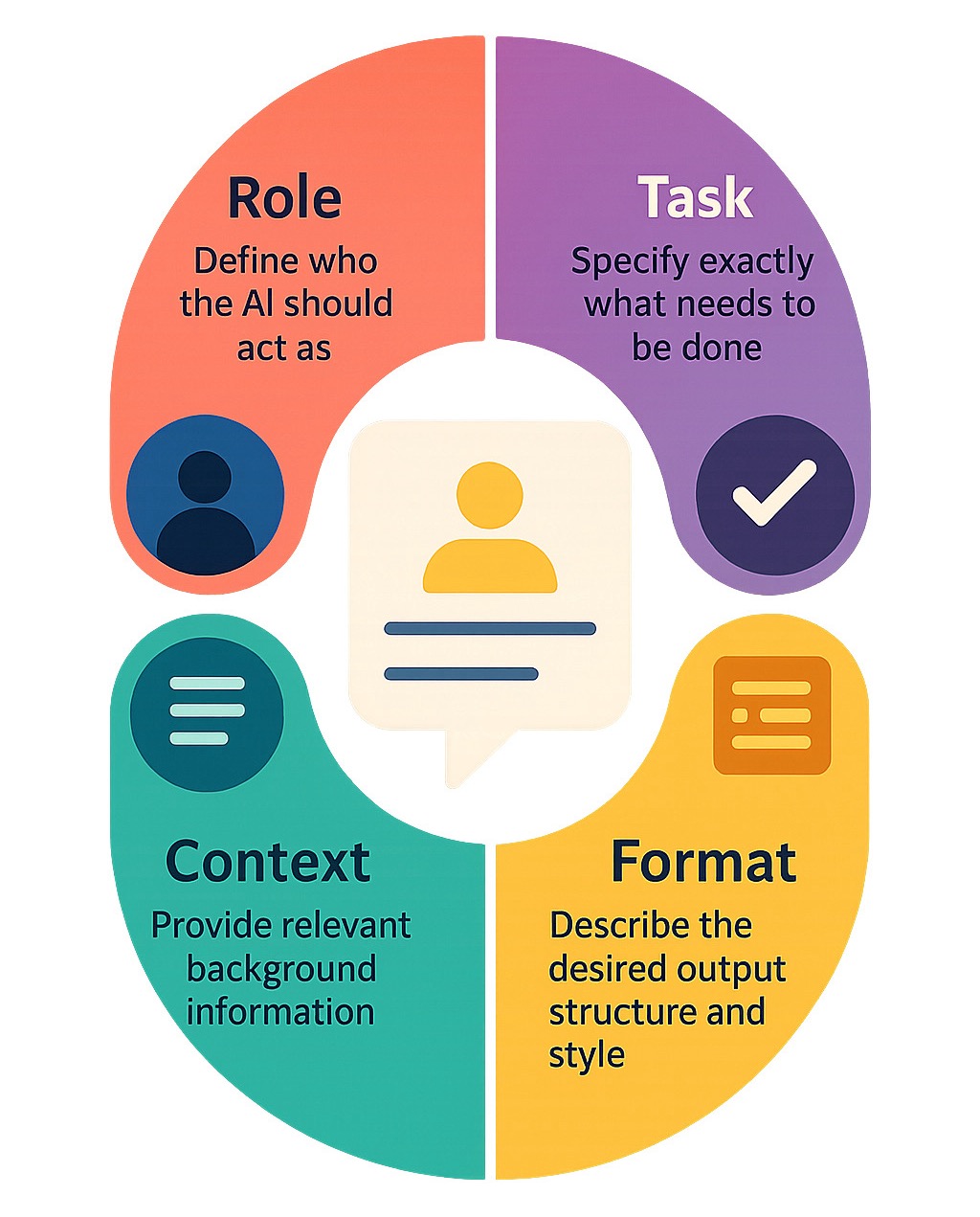4 Essential Strategies for Better AI Prompt Templates
Why AI Prompt Templates Are Your Secret Weapon for Better Results.

An AI prompt template is a pre-designed structure that combines fixed instructions with variable placeholders, allowing you to create consistent, effective prompts without starting from scratch each time.
Quick Answer for AI Prompt Templates:
- Definition: Reusable prompt frameworks with placeholders for dynamic content
- Key Components: Role, task, context, and output format
- Main Benefits: Consistency, time-saving, better results, and scalability
- Best Use Cases: Repetitive tasks, team collaboration, and complex multi-step processes
If you've ever been disappointed by an AI's response, you're not alone. The problem often isn't the AI, but the prompt. As one expert puts it, it's like asking a new teammate to "make me a proposal" without any context.
The truth is simple: garbage in, garbage out. Even small changes in wording can improve AI accuracy by as much as 76%. This is where prompt templates become game-changers. Instead of starting from scratch, you use a proven blueprint. While many people are "blind prompting," professionals use templates to get better results with less effort.

Strategy 1: Understand the Blueprint of a Powerful Prompt Template
Think of an AI prompt template as a recipe. Instead of vague requests, a well-crafted template provides a blueprint for consistently excellent results. It combines fixed content (your core instructions) with variable content (specific data that changes), turning guesswork into a reliable process.
This is similar to how software applications work, where static instructions are paired with dynamic data. A template uses placeholders for the changing parts, allowing you to test different inputs without rewriting the entire prompt.
The Core Components of an Effective Template
Every powerful AI prompt template is built on seven essential building blocks:
- Task: Clearly define what you want the AI to do. Use strong action verbs like "summarize," "generate," or "analyze." For example, instead of "help with this article," say "summarize this 2,000-word article into five key takeaways for busy executives."
- Context: Provide the "why" and background information. Assume the AI knows nothing about your project. Share objectives and relevant details to give it the bigger picture.
- Examples: Show the AI what success looks like. Providing a sample of your desired output, a technique known as "few-shot prompting," eliminates ambiguity and dramatically improves results.
- Persona: Define who the AI should be. Assigning a role like "expert copywriter" or "patient customer service representative" frames the AI's responses and ensures the right perspective.
- Format: Specify how the response should be structured. Whether you need bullet points, a JSON object, or a formal report, being specific helps the AI deliver information in a usable format.
- Tone: Set the emotional vibe of the output, such as professional, friendly, or urgent. This helps the AI craft responses that resonate with your target audience.
- Constraints: Establish boundaries and rules. These "guardrails" might include character limits, topics to avoid, or guidelines like "don't use technical jargon."
Best Practices for Crafting and Using Templates
Creating effective AI prompt templates is both an art and a science. Follow these best practices for success:
- Be Clear and Specific: The AI is literal. It will do exactly what you ask, not what you meant. Specify the topic, audience, length, and key points to cover.
- Use the Single Responsibility Principle: Break complex tasks into smaller, manageable prompts. Don't ask the AI to do too much at once.
- Apply Negative Constraints: Sometimes telling the AI what not to do is as powerful as telling it what to do. For example, "DON'T use jargon."
- Start with Action Verbs: Use words like "write," "compare," and "analyze" to clarify your intent from the beginning.
- Iterate and Refine: Your first draft is rarely perfect. Test, track what works, and refine your templates. This is why we built version control into Potions. More info about Potions features.
Research shows that small wording changes can improve AI accuracy by up to 76%. This highlights why careful prompt design is the difference between getting an answer and getting the right answer. For deeper insights, check out this study on prompt wording.
Here's a quick comparison that shows the difference structure makes:
| Feature | Simple Prompt | Structured AI Prompt Template - |
|---|---|---|
| Clarity | "Write a blog post about remote work" | "Write a 1,000-word blog post for a tech startup's blog. The target audience is project managers. The tone should be professional yet approachable. The post should cover the benefits of remote work, challenges, and best practices for managing a remote team. Include a call-to-action to download our free remote work guide." |
| Structure | "Give me some marketing ideas" | "Generate 5 unique marketing campaign ideas for a new eco-friendly water bottle. For each idea, provide: 1. A catchy slogan. 2. The primary target audience. 3. Key marketing channels (e.g., Instagram, TikTok, email). 4. A brief description of the campaign concept." - |
| Persona | "Explain quantum computing" | "Explain quantum computing to a 12-year-old using a simple analogy. Act as a friendly and patient science teacher." - |
| Constraints | "Write a short story" | "Write a short story (under 500 words) about a robot who finds music for the first time. Do not use the word 'robot' or 'android'." - |
Strategy 2: Find Proven Templates in Community Hubs and Potions' Own Library

You don't need to reinvent the wheel with every AI prompt template. Instead, you can leverage the collective intelligence of a community. At Potions, we've built our platform around this idea, allowing users to share, improve, and build upon each other's work. Every prompt is versioned with a unique URL, so you can track what works, experiment, and see how others have refined your ideas.
Beyond our library, professional forums and communities are also valuable resources for sharing knowledge and solving prompt engineering challenges.
Finding Your First AI Prompt Template
When exploring our library, keep these tips in mind:
- Start with your goal: Are you writing marketing copy, summarizing research, or generating code? A clear objective helps you find relevant templates quickly.
- Filter by AI model: A prompt that works for GPT-4 might need tweaks for Claude or Gemini. Filtering by your model saves time.
- Check usage and ratings: Templates with high usage and positive ratings are often a great starting point.
- Remix and adapt: Don't hesitate to take a proven AI prompt template and customize it. A customer service template might be adapted for technical support, or a creative writing prompt could inspire your marketing copy. Explore prompt templates and see what you can create.
Deconstructing System Prompts for Inspiration
For a masterclass in prompt engineering, look at the system prompts that power the AI models themselves. These are massive, carefully crafted templates that define the AI's core behavior. For example, some models have system prompts that are thousands of words long, with a significant portion dedicated to specific instructions like how to handle search queries.
These expert-crafted examples reveal sophisticated techniques for defining roles, setting constraints, and managing tool usage. They show how to handle complex scenarios, from ethical dilemmas to admitting uncertainty. Studying these can dramatically improve your own prompt crafting skills. We regularly analyze these prompts and share insights on our Potions blog. By seeing how experts structure complex instructions, you can learn patterns and techniques to apply to your own AI prompt templates.
Strategy 3: Boost Your Results with Advanced Prompting Techniques

Once you've mastered the basics of an AI prompt template, you can use advanced techniques to open up the AI's deeper reasoning abilities. These methods transform your AI interactions from simple Q&As into sophisticated problem-solving partnerships.
Using Prompt Modifiers to Refine Your Output
Prompt modifiers are small additions to your AI prompt template that can significantly change the output. They help you fine-tune the AI's behavior and the format of its response.
- Role-playing: "Act as an experienced journalist" gives the AI a specific perspective.
- Writing style: "Write in a persuasive tone" controls the voice and feel.
- Output format: "Format as a JSON object" dictates the structure of the response.
- Perspective: "Use a first-person viewpoint" changes the narrative stance.
- Target audience: "Explain this to a high school student" adjusts the complexity.
Combining modifiers, like "Act as an experienced couples therapist and speak in a calm, empathetic tone," creates even more nuanced and effective results.
Integrating Techniques like Chain-of-Thought and SPP
For complex tasks, advanced prompting techniques like Chain-of-Thought (CoT) and Solo Performance Prompting (SPP) are game-changers.
Chain-of-Thought (CoT) prompting encourages the AI to "show its work." By adding phrases like "Let's think step by step," you guide the AI through a logical process, which dramatically improves accuracy for complex problems.
Solo Performance Prompting (SPP) takes this further by having the AI create and manage a team of internal "expert" personas. These personas collaborate to analyze a problem from multiple angles, leading to more robust solutions. Research shows SPP can outperform CoT on complex reasoning tasks. You can explore more about this in this research paper.
These techniques transform your AI prompt template from a simple instruction into a guide for sophisticated thinking, ideal for strategic planning, creative problem-solving, and more.
Strategy 4: Accept Iteration to Avoid "Good Enough" Results

Many people give up on their AI prompt template too early, settling for mediocre results after just one or two attempts. The difference between a frustrating AI interaction and an impressive one often comes down to embracing iteration.
Think of it like refining a recipe. The first attempt might be okay, but small adjustments transform it into something great. This is why we built version control into Potions. Every time you refine a prompt, we automatically save a new version, allowing you to track changes, compare approaches, and roll back if needed. This turns prompt engineering from guesswork into a systematic craft.
The Iterative Loop: Test, Analyze, Refine
Mastering prompts follows a simple loop:
- Start with a baseline: Create your first structured prompt using the components discussed earlier (role, task, context, format).
- Analyze the output: Run the prompt and see where it falls short. Is it inaccurate, poorly formatted, or off-tone?
- Identify the gaps: Pinpoint the problem. Is the context too thin? Are the instructions ambiguous?
- Make targeted tweaks: Make one or two specific changes at a time. Add more context, clarify an instruction, or include an example.
- Track and test: Use version control to see what changes improve results. A/B test different versions for important prompts.
Most successful prompts go through at least 3-5 rounds of refinement. This isn't failure; it's optimization.
Common Challenges and How to Overcome Them
You'll likely encounter these common issues:
- Vague outputs: The AI needs more specific direction. Add context, define the persona more clearly, or include examples.
- Hallucinations (made-up information): The AI is guessing. Build in "escape hatches" by instructing it to say "I don't know" when it lacks information or to ask for clarification.
- Overly rigid templates: If your output feels robotic, give the AI more creative freedom by loosening some constraints.
AI models, like human teammates, improve with feedback and calibration. By embracing an iterative mindset, you can systematically create great results instead of just hoping for them.
Frequently Asked Questions about AI Prompt Templates
What is the difference between a regular prompt and an AI prompt template?
A regular prompt is a one-off instruction, like "Write a poem about the ocean." An AI prompt template is a reusable framework with fixed instructions and variable placeholders. For example: "As a [ROLE], write a [TYPE_OF_CONTENT] about [TOPIC]." This allows you to generate consistent, high-quality results for repeated tasks by simply changing the variables. Templates save time, improve quality, and enable collaboration.
How detailed should my AI prompt template be?
Your template should be detailed enough to be clear but concise enough to be practical. Always include the core components: a role for the AI, a specific task, essential context, and a defined output format. For complex requests, break the task into smaller steps within the template. The goal is to provide enough information to guide the AI without creating a confusing wall of text.
Can I use the same prompt template across different AI models?
While you can start with the same template, you'll get the best results by adapting it for each AI model (e.g., GPT-4, Claude, Gemini). Each model has unique strengths and responds differently to certain instructions. The fundamental components (role, task, context, format) are universal, but fine-tuning the details for each model is key. Start with a base template and then test and refine it for each platform to optimize performance.
Conclusion: Transform Your AI Interactions from a Guess to a Science
We've explored how an AI prompt template can transform your AI interactions from guesswork into a reliable process. You've learned the blueprint of a powerful template, where to find proven examples, and how to use advanced techniques like Chain-of-Thought and Solo Performance Prompting to get better results.
The key takeaway is that iteration is everything. The first version of a prompt is rarely the best. By systematically testing, analyzing, and refining your templates, you move from hoping for good results to engineering them.
This is where the power of collaboration becomes essential. At Potions, we've built our entire platform around the idea that prompt engineering is a team sport. Our version control system automatically saves and tracks every change, allowing you to experiment freely and build upon the work of others.
Versioning and remixing are the foundation of our learning community. When you adapt a template and share your improvements, everyone benefits. This collective intelligence is far more powerful than any individual effort. Potions transforms prompt engineering from a solo skill into a collaborative craft, giving you access to hundreds of proven prompts you can use and improve.
Ready to stop guessing and start engineering your AI interactions with confidence?